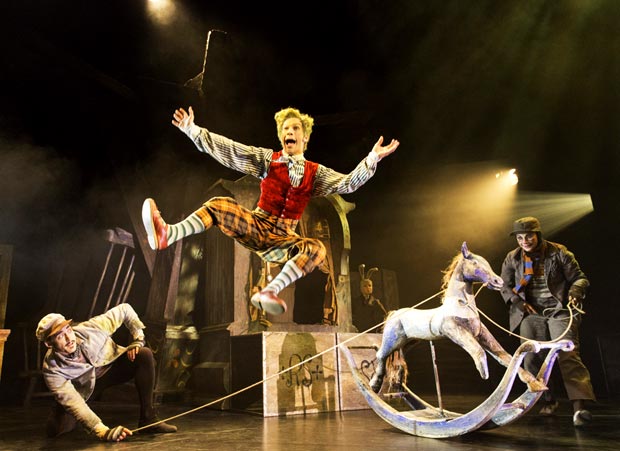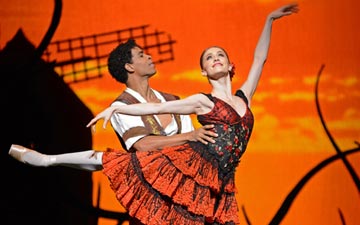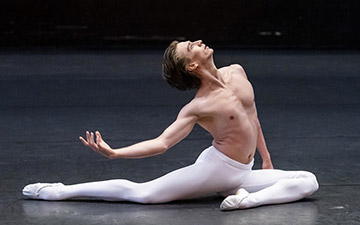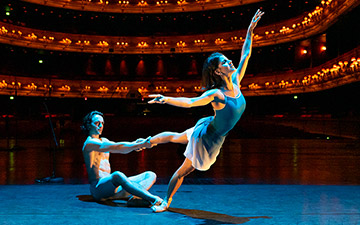
© Johan Persson. (Click image for larger version)
Royal Opera House production of Will Tuckett’s
The Wind in the Willows
London, Duchess Theatre,
18 December 2013
www.roh.org.uk
www.duchesstheatre.co.uk
“A plan,” intones Tony Robinson. A plan to reclaim to Toad Hall. As Kenneth Grahame, the narrator who steers the action in Will Tuckett’s The Wind in the Willows, Robinson plays it straight. He is avuncular, confiding, authoritative – though the production is discreetly amplified. The rapid patter of Andrew Motion’s narration poses no terrors for Robinson and he gets to sing too, a pleasing light baritone.
“Is it a ballet?” my neighbour asked her companion. “Well, dance,” was the reply. In truth, there is no label that encompasses Tuckett’s version. Yes there is some dance – which tends to hold up the storytelling – but the influence of Morris men is as strong as ballet, there is burlesque, some slapstick humour, singing, puppetry and physical theatre. Above all there is Martin Ward’s music inspired by George Butterworth, nostalgic and evocative of gentler times. The overriding tone of the show is mellowness.
For whom the faux naïf tone is designed I am uncertain. There’s nostalgia aplenty for adults who knew the story in their own childhood (I didn’t – my guest commented the realisation of the characters here is nothing like her imagination of them) – and there is a magic in storytelling conjured from the simplest of theatrical means that entranced children experiencing the story for the first time. But the reaction of a mixed audience – adults and youngsters alike – was fairly muted.

© Johan Persson. (Click image for larger version)
We are in Kenneth Grahame’s attic. The story is told with the simplest of props – an ever-versatile wardrobe, a kitchen chair. The river is unfolded from a drawer as a length of blue and white striped fabric. Crocheted ducks top knitted balaclavas, butterflies are imagined from gloved hands. We first discover the timid Mole twitching free of a rolled up rug – the gentle and touching Clemmie Sveaas, a beautifully subtle performance.
The first half is slow to catch light, surprising for a show that has been honed over previous revivals at the Linbury studio at the Royal Opera House. Pacing is slack; the disparate elements – narrative, dance, action, song – do not cohere. The ever-scampering steps for Ratty and Toad, crowded on a small stage, do not convey character or narrative. Badger is defined only by his silken black coat. By the time we reach his sett and plans are afoot to tunnel to Toad Hall, dramatic propulsion has sagged. But Tuckett sends us into the interval happy with carol singing and some magical stagecraft (no, I’m not telling you what – go see!).
There is altogether more energy and flair at work in the second half, full of vigour and wit. In a train chase words, music and movement feed off each other to create genuine excitement. The creatures from the Wild Wood who colonise Toad Hall are characterised by knitted glove puppets (creepy) and West Side Story-style sharks and jets – creepy and funny. A giant ribbed chair is upended, its slats become the bars of Toad’s prison cell – a beautifully economic and graphic idea.

© Johan Persson. (Click image for larger version)
The show’s highlight is the Gaoler’s Daughter – a deadpan Ewan Wardrop in drag – a witty combination of Widow Simone from La Fille mal gardée and a tassel-twirling burlesque artiste. Matching him is Will Kemp as Ratty, full of melodramatic energy. Every raised eyebrow, shrug and grimace played to the gallery in a deliciously witty way.
I wish I could be enthusiastic about Cris Penfold as Toad but his manic energy feels forced and artificial. He does not pull our heart strings while in gaol as Toad should. But Toad came impressively home in a mock finale, a glorious chorale. As order is restored and the natural world falls asleep, Robinson sends us to our homes, mellow, in a perfectly caught diminuendo.
The Wind in the Willows is the Royal Opera House’s first transfer to the West End. I hope other shows will follow. It is a model that has subsidised the RSC’s operations for many years. Put Alice’s Adventures in Wonderland cast with commercial dancers into the Palladium and I wager that audiences who enjoy big musicals would discover something to tempt them gently towards dance.

















You must be logged in to post a comment.